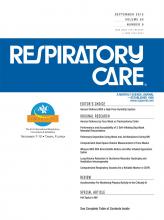Aerosol delivery applied with different interfaces has become an important topic of interest among respiratory care practitioners across the continuum. Thanks to the work of Lin et al,1 presented in this issue of Respiratory Care, clarification of details surrounding the selection of aerosol interface with high-flow systems for infants and children has finally come to fruition. As aerosol technology has evolved, so too has evidence-based knowledge and recommendations for clinical practice. As all of the pieces of this complicated puzzle continue to be gathered, perhaps new directions for aerosol delivery are being established.
It has long been standard to deliver aerosolized medication via a simple, inexpensive mask and nebulizer for pediatric patients or infants. It has been assumed by many that medicated aerosol delivered with a mask is adequate and efficient. Due to lack of compelling evidence to substantiate changing the practice, there have been no major clinically relevant modifications implemented for quite some time. As aerosol delivery continued to be examined, efficiency of drug delivery became a primary focus. With the emphasis placed on effectiveness of treatment and cost of therapy, clinicians demanded guidance on standards and recommendations for aerosol delivery. Over the past decade, new devices including aerosol adjuncts have been proposed in response to the unmet needs of easily achieving optimum drug delivery in the face of variable breathing patterns such as those in infants and pediatric patients. Research on the mechanics of aerosol delivery continues to develop and offer clinically relevant information at a faster pace than in the past. The aspects of aerosol therapy (mechanics, applications, and medication delivery) continue to unfold.
The variety of models used to study aerosolized medication delivery has seen its greatest development over the past decade. This has strengthened the confidence in research outcomes. Greater sophistication and technology are available, making these models highly reliable while concurrently blazing a trail for researchers to investigate more complex systems. As investigators perform studies to determine adequate medication delivery, physiologic and clinical factors have been identified, and types of delivery devices can now be validated.
With the increase in high-flow nasal cannula (HFNC) use over the past decade, intermittent aerosol delivery through this interface has recently evolved. Creative solutions for delivering medication via an HFNC were needed, researched, and just recently became available, but not without moderate limitations for clinical practice. For example, research on aerosol therapy via an HFNC using a vibrating mesh nebulizer demonstrated that as HFNC flow increases, medication delivery decreases.2 Although benefits of maintaining the HFNC system during aerosol therapy were achieved, constraints on maintaining consistent drug delivery in the face of rising nasal cannula flow were realized. Managing condensation in the HFNC system with added aerosol delivery using a vibrating mesh nebulizer continues to be a work in progress, especially in situations requiring frequent or continuous use. So where is the balance? What is the best choice in the face of increased flow? Lin et al1 demonstrated that up to 3 L/min with an HFNC system provided adequate medication delivery, but high-flow humidification systems with a mask and vibrating mesh nebulizer were more capable and efficient in delivering medication in the case of rising flow. At maximum mask flows (12 L/min), drug delivery also decreased. This implies that higher doses (or higher concentrations) of medications may be required with increased HFNC flow (> 3 L/min) or with a mask (> 12 L/min).1
Other considerations than need to be taken into account include mask design. The incidence of drug delivered to the eyes, face, and nose is impacted by the type, size, shape, and dead space of the mask.1,3 In addition, the selection of mask size and the amount of leak around it affect medication delivery.4 As a clinician considers the many factors that affect aerosol delivery, those impacting delivery via a heated-and-humidified mask or nasal cannula need to be considered. When selecting the type of delivery device for aerosol therapy, the simplest, most cost-effective choice may no longer be the best option.
As aerosol therapy studies continue to emerge, the scope of providing ideal choices for drug delivery is ever-changing. A single delivery method no longer applies, nor to all situations. As demonstrated by Lin et al,1 the breathing patterns (rate and depth of respiration) directly affect drug delivery, whereas particle size and distribution are impacted by the gas carrier and the accompanying flow.4 Perhaps mask delivery of aerosolized medication with heated-and-humidified gas is the accepted alternative at specified higher flows, whereas HFNC aerosol delivery is limited to lower flows.
Many options exist for aerosol medication delivery. Selection of the appropriate device is critical to achieve the optimum drug delivery in a judicious fashion. Lin et al1 present one of many examples demonstrating why aerosol delivery evidence-based knowledge matters! Outcomes related to application of specific devices used to achieve drug delivery goals are forthcoming.
Footnotes
- Correspondence: Kathleen M Deakins MHA RRT-NPS FAARC, Women's and Children's Respiratory Care and Respiratory Diagnostic Services, University Hospitals Rainbow Babies and Children's Hospital, 11100 Euclid Avenue Cleveland, OH 44106. E-mail: kathleen.deakins{at}uhhospitals.org.
Ms Deakins discloses relationships with Masimo and Hill-Rom.
- Copyright © 2015 by Daedalus Enterprises











